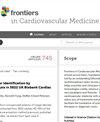基于机器学习和孟德尔随机法探讨 CRP 和淋巴细胞对冠心病的预测价值
IF 2.8
3区 医学
Q2 CARDIAC & CARDIOVASCULAR SYSTEMS
引用次数: 0
摘要
目的 研究白细胞亚群和 C 反应蛋白(CRP)对冠状动脉疾病(CAD)的预测价值。方法 我们对白细胞亚群、C 反应蛋白(CRP)和 CAD 进行了孟德尔随机分析(MR),纳入了 2010 年至 2022 年期间接受冠状动脉造影术的 68624 名患者的数据。经过初步筛选后,对 46,664 名患者的临床数据进行了分析。采用的技术包括倾向评分匹配(PSM)、逻辑回归、拉索回归和随机森林算法(RF)。对风险因素进行了评估,并使用接收器操作特征曲线(ROC)对模型的灵敏度和特异性进行了评估。结果逆方差权重(IVW)分析表明,嗜碱性粒细胞计数(OR 0.92,95% CI:0.84-1.00,P = 0.048)、CRP 水平(OR 0.87,95% CI:0.73-1.00,P = 0.040)和淋巴细胞计数(OR 1.10,95% CI:1.04-1.16,P = 0.001)是导致 CAD 的重要危险因素。通过 LASSO 回归、逻辑回归和 RF 分析,CRP 和淋巴细胞计数被一致认定为 PSM 之前和之后的 CAD 危险因素。ROC 曲线分析表明,PSM 后淋巴细胞和 CRP 水平的组合具有更高的诊断价值(0.85)。生存分析表明,高淋巴细胞计数和低 CRP 水平与重大不良心血管事件(MACE)风险降低有关(P < 0.001)。结论淋巴细胞、CRP 和 CAD 之间存在因果关系。结论淋巴细胞、CRP 和 CAD 之间存在因果关系,联合评估 CRP 和淋巴细胞对 CAD 具有诊断价值。此外,高 CRP 水平和低淋巴细胞计数与不良预后相关。本文章由计算机程序翻译,如有差异,请以英文原文为准。
Exploring the predictive values of CRP and lymphocytes in coronary artery disease based on a machine learning and Mendelian randomization
PurposeTo investigate the predictive value of leukocyte subsets and C-reactive protein (CRP) in coronary artery disease (CAD).MethodsWe conducted a Mendelian randomization analysis (MR) on leukocyte subsets, C-reactive protein (CRP) and CAD, incorporating data from 68,624 patients who underwent coronary angiography from 2010 to 2022. After initial screening, clinical data from 46,664 patients were analyzed. Techniques employed included propensity score matching (PSM), logistic regression, lasso regression, and random forest algorithms (RF). Risk factors were assessed, and the sensitivity and specificity of the models were evaluated using receiver operating characteristic (ROC) curves. Additionally, survival analysis was conducted based on a 36-month follow-up period.ResultsThe inverse variance weight (IVW) analysis showed that basophil count (OR 0.92, 95% CI: 0.84–1.00, P = 0.048), CRP levels (OR 0.87, 95% CI: 0.73–1.00, P = 0.040), and lymphocyte count (OR 1.10, 95% CI: 1.04–1.16, P = 0.001) are significant risk factors for CAD. Using LASSO regression, logistic regression, and RF analysis, both CRP and lymphocyte counts were consistently identified as risk factors for CAD, prior to and following PSM. The ROC curve analysis indicated that the combination of lymphocyte and CRP levels after PSM achieves a higher diagnostic value (0.85). Survival analysis revealed that high lymphocyte counts and low CRP levels are associated with a decreased risk of Major Adverse Cardiovascular Events (MACE) (P < 0.001). Conversely, a higher CRP level combined with lymphocyte counts correlates with a poorer prognosis.ConclusionThere is a causal relationship between lymphocytes, CRP and CAD. The combined assessment of CRP and lymphocytes offers diagnostic value for CAD. Furthermore, high CRP levels coupled with low lymphocyte counts are associated with a poor prognosis.
求助全文
通过发布文献求助,成功后即可免费获取论文全文。
去求助
来源期刊

Frontiers in Cardiovascular Medicine
Medicine-Cardiology and Cardiovascular Medicine
CiteScore
3.80
自引率
11.10%
发文量
3529
审稿时长
14 weeks
期刊介绍:
Frontiers? Which frontiers? Where exactly are the frontiers of cardiovascular medicine? And who should be defining these frontiers?
At Frontiers in Cardiovascular Medicine we believe it is worth being curious to foresee and explore beyond the current frontiers. In other words, we would like, through the articles published by our community journal Frontiers in Cardiovascular Medicine, to anticipate the future of cardiovascular medicine, and thus better prevent cardiovascular disorders and improve therapeutic options and outcomes of our patients.
 求助内容:
求助内容: 应助结果提醒方式:
应助结果提醒方式:


